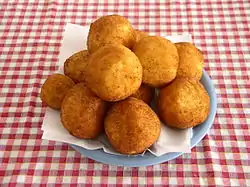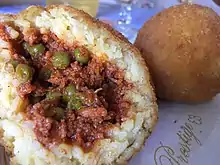Arancini
Arancini (Italian: [aranˈtʃiːni], Sicilian: arancini or arancine, Sicilian: [aɾanˈtʃiːnɪ, -ˈdʒiː-], UK: /ˌærənˈtʃiːni/, US: /ˌɑːr-/)[1][2] are Italian snacks consisting of a ball of rice coated with bread crumbs and then deep fried—a staple of Sicilian cuisine. The most common fillings are: al ragù or al sugo, filled with ragù (meat or mince, slow-cooked at low temperature with tomato sauce and spices), mozzarella and/or caciocavallo cheese, and often peas, and al burro or ô burru, filled with ham and mozzarella or besciamella.
 Sicilian arancini for sale at a counter | |
| Type | Snack, street food |
|---|---|
| Place of origin | Italy |
| Region or state | Sicily |
| Serving temperature | Hot or warm |
| Main ingredients | rice, ragù |
A number of regional variants exist which differ in fillings and shape. Arancini al ragù produced in eastern Sicily have a conical shape inspired by the volcano Etna.[3]
Etymology
Arancini is a diminutive of arancia, or 'orange'. The name, which is translated as "little orange", derives from their shape and colour which, after cooking, is reminiscent of an orange.[3] In Italian, arancini is grammatically plural (Sicilian: arancine); the corresponding singular is arancino (Sicilian: arancinu or arancina).[4][5]
History

Arancini are said to have originated in 10th-century Sicily at a time when the island was under Arab rule.[6][7]
In the cities of Palermo, Siracusa, and Trapani in Sicily, arancini are a traditional food for the feast of Santa Lucia on 13 December when bread and pasta are not eaten. This commemorates arrival of a grain supply ship on Santa Lucia's day in 1646, relieving a severe famine.[8]
Today, with the increasing popularity of this finger food in modern Italian food culture, arancini are found all year round at most Sicilian food outlets,[lower-alpha 1] particularly in Palermo, Messina and Catania. The dish was traditionally created to provide a full meal to Federico II di Svevia during his hunting activities.
Ingredients and variations

The most common type of arancini sold in Sicilian cafés are arancini al ragù, which typically consist of meat in a tomato sauce, rice, and mozzarella or other cheese. Many cafés also offer arancini al burro (with butter or béchamel sauce) or specialty arancini, such as arancini con funghi (mushrooms), con pistacchi (pistachios), or con melanzane (aubergine).
In Roman cuisine, supplì are similar but are commonly filled with cheese (different preparation methods and filling distribution). In Naples, rice balls are called pall'e riso. In a variant recipe originating among the Italian diaspora in Southeast Texas, the arancini are stuffed with a chili-seasoned filling.[10]
In popular culture
In Italian literature, Inspector Montalbano, the main character of Andrea Camilleri's detective novels, is a well-known lover of arancini especially those made by Adelina Cirrinciò, his housekeeper and cook. The success of the book series and the television adaptation has contributed to making this dish known outside of Italy.[11]
See also
- Italian cuisine
- Sicilian cuisine
- List of Sicilian dishes
- List of stuffed dishes
- Pani ca meusa – another example of Sicilian street food
Notes
- "However, as soon as any foreigner arrives in Sicily, his first encounter with the cuisine will be with rice croquettes, called arancini. They are sold everywhere, in fry stands on the beach, in cafes, and in bars serving hot food (tavola calda)."[9]
References
- "Arancini". Collins English Dictionary. HarperCollins. Retrieved 20 May 2019.
- "arancini" (US) and "arancini". Oxford Dictionaries UK Dictionary. Oxford University Press. Retrieved 20 May 2019.
- Chef Rubio (2014). Sperling & Kupfer (ed.). Unti e bisunti.
- "I cugini di Palerma e il sesso degli arancini. Un complesso di inferiorità culinaria". MeridioNews (in Italian). Archived from the original on 2014-08-11. Retrieved 2014-08-15.
- "Arancina o arancinu? Una risposta esaustiva - Cadèmia Siciliana". Cadèmia Siciliana (in Italian). 30 December 2017. Retrieved 4 January 2018.
- Giuliano Valdes (1 May 2000). Sicilia. Ediz. Inglese (illustrated ed.). Casa Editrice Bonechi. p. 9. ISBN 9788870098266.
- Clifford A. Wright (1 Jan 2003). Little Foods of the Mediterranean: 500 Fabulous Recipes for Antipasti, Tapas, Hors D'Oeuvre, Meze, and More (illustrated ed.). Harvard Common Press. p. 380. ISBN 9781558322271.
- Giuseppina Siotto, Vegetaliana, note di cucina italiana vegetale: La cucina vegetariana e vegana, 2014, ISBN 8868101858, chapter 14
- Muffoletto, A. (1971). The art of Sicilian cooking. Doubleday. p. 52. Retrieved 4 January 2020.
- "Arancini". Texas Monthly. 1 December 1988.
- "I arancini di Montalbano". Rai Uno. 6 July 2015. Archived from the original on 17 July 2015.
External links
 Media related to Arancini at Wikimedia Commons
Media related to Arancini at Wikimedia Commons- Arancino recipe at BBC Food
